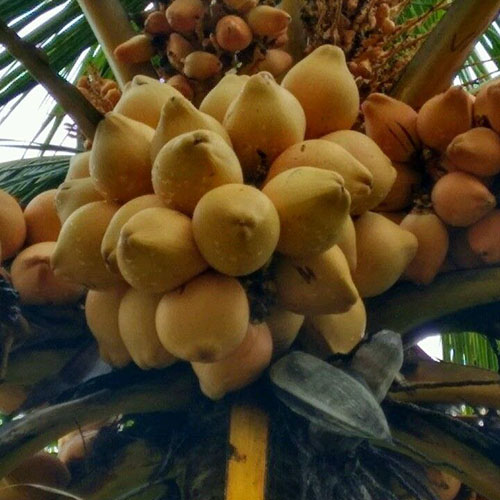Yellow Dwarf Coconut Plants
Yellow dwarf coconut plants, also known as "Malayan Yellow Dwarf" coconuts, are a popular variety of coconut palm characterized by their vibrant yellow fronds and smaller stature. They are widely cultivated for both ornamental and agricultural purposes due to their unique appearance and favorable characteristics.
Characteristics
-
Height: Yellow dwarf coconut trees are smaller in size compared to the tall coconut varieties, typically growing up to 20-30 feet (6-9 meters) in height. This makes them easier to manage and harvest.
-
Appearance: The defining feature of yellow dwarf coconut palms is their bright yellow to golden-yellow fronds and coconuts, which stand out in a landscape. The trunk is slender and straight, and the leaves are arching and pinnate, adding an aesthetic appeal to gardens and landscapes.
-
Fruit Production: These coconut palms are known for their early fruit-bearing capabilities, often starting to produce coconuts within 3-4 years after planting. They produce small to medium-sized coconuts with a yellowish husk that deepens in color as the fruit matures.
-
Fruit Characteristics: The coconuts have sweet water and soft, tender meat when young, which is ideal for drinking and eating fresh. As the fruit matures, the meat becomes thicker and can be used for making coconut milk or oil.
-
Disease Resistance: Yellow dwarf coconuts have a notable resistance to lethal yellowing disease, which makes them a preferred choice in areas where this disease is prevalent.
-
Climate and Soil: Yellow dwarf coconut palms thrive in tropical and subtropical climates with plenty of sunlight and regular rainfall. They prefer well-draining sandy or loamy soils rich in organic matter.
Benefits
- Ornamental Value: The bright yellow fronds and manageable height make yellow dwarf coconut palms an attractive addition to landscapes, gardens, and public spaces.
- Ease of Harvest: Due to their shorter stature, coconuts from yellow dwarf palms are easier to harvest compared to those from taller varieties.
- Early and Consistent Yields: These palms are known for producing coconuts relatively quickly after planting and maintaining consistent yields over time.
- Nutritional Value: The water and meat of the yellow dwarf coconut are nutritious, with a naturally sweet taste that is highly sought after for fresh consumption and culinary uses.
Growing and Care Requirements
-
Sunlight: Plant yellow dwarf coconut palms in locations where they receive full sun for at least 6-8 hours a day, which is essential for healthy growth and fruit production.
-
Watering: Ensure regular watering, especially in dry periods, while maintaining well-draining soil to avoid waterlogging and root rot. A consistent supply of moisture is crucial for optimal growth.
-
Fertilization: Apply a balanced, slow-release fertilizer specially formulated for palms every 3-4 months during the growing season. This helps promote strong growth and healthy fruit production.
-
Pruning: Regularly remove dead or damaged fronds to keep the tree healthy and reduce the risk of pest infestations.
-
Spacing: Plant the yellow dwarf coconut palms about 20-25 feet (6-7.5 meters) apart to allow adequate space for growth and sunlight exposure.
-
Pest and Disease Control: Monitor for pests such as the coconut rhinoceros beetle and red palm weevil, which can damage the palm. Apply appropriate pest management strategies as needed.
Would you like more information on cultivating yellow dwarf coconut palms or their specific uses?


